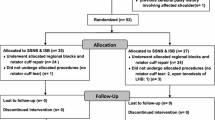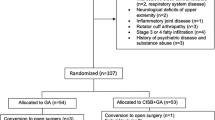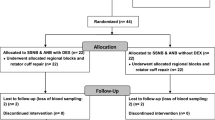Abstract
Purpose
The goal of the study was to evaluate the efficacy of additional axillary nerve block (ANB) with suprascapular nerve block (SSNB) and patient-controlled anaesthesia (PCA) with no device assistance after arthroscopic rotator cuff repair. The hypothesis is that patients with intravenous (IV) PCA and the blockade of the two main nerves (SSNB + ANB) experienced lesser pain than patients with IV PCA or IV PCA + SSNB.
Methods
The 114 patients undergoing arthroscopic rotator cuff repair were allocated randomly to three groups as follows: group I, intravenous PCA pumps (only PCA); group II, IV PCA + SSNB using a blind technique (PCA + SSNB); and group III, IV PCA + SSNB + ANB using a blind technique (PCA + SSNB + ANB). Pain visual analogue scale (VAS) scores were evaluated at 1, 6, 12, 24, 36, and 48 post-operative hours. Furthermore, the degree of pain was compared according to cuff tear size.
Results
The pain VAS score of group III was lower than that of the other two groups and was significantly lower at post-operative hours 1, 6, and 12. In addition, the larger cuff tear tended to be indicative of greater pain. However, all groups experienced rebound pain.
Conclusion
PCA + SSNB + ANB using a blind technique is a better pain control method than PCA + SSNB and only PCA during the initial 12 post-operative hours. PCA + SSNB + ANB is a cost-effective, time-saving, and easily performed method for post-operative pain control as an axis of multimodal pain control strategy.
Level of evidence
II.



Similar content being viewed by others
References
Al-Nasser B (2012) Review of interscalene block for postoperative analgesia after shoulder surgery in obese patients. Acta Anaesthesiol Taiwan 50:29–34
Barber FA (2005) Suprascapular nerve block for shoulder arthroscopy. Arthroscopy 21(8):1015
Bishop JY, Sprague M, Gelber J, Krol M, Rosenblatt MA, Gladstone J, Flatow EL (2005) Interscalene regional anesthesia for shoulder surgery. J Bone Joint Surg Am 87(5):974–979
Borghi B, Facchini F, Agnoletti V, Adduci A, Lambertini A, Marini E, Gallerani P, Sassoli V, Luppi M, Casati A (2006) Pain relief and motor function during continuous interscalene analgesia after open shoulder surgery: a prospective, randomized, double-blind comparison between levobupivacaine 0.25 %, and ropivacaine 0.25 % or 0.4 %. Eur J Anaesthesiol 23(12):1005–1009
Casati A, Borghi B, Fanelli G, Montone N, Rotini R, Fraschini G, Vinciguerra F, Torri G, Chelly J (2003) Interscalene brachial plexus anesthesia and analgesia for open shoulder surgery: a randomized, double-blinded comparison between levobupivacaine and ropivacaine. Anesth Analg 96(1):253–259
Checcucci G, Allegra A, Bigazzi P, Gianesello L, Ceruso M, Gritti G (2008) A new technique for regional anesthesia for arthroscopic shoulder surgery based on a suprascapular nerve block and an axillary nerve block: an evaluation of the first results. Arthroscopy 24(6):689–696
Cho CH, Song KS, Min BW, Jung GH, Lee YK, Shin HK (2015) Efficacy of interscalene block combined with multimodal pain control for postoperative analgesia after rotator cuff repair. Knee Surg Sports Traumatol Arthrosc 23(2):542–547
Chung F, Ritchie E, Su J (1997) Postoperative pain in ambulatory surgery. Anesth Analg 85(4):808–816
Cummings KC 3rd, Napierkowski DE, Parra-Sanchez I, Kurz A, Dalton JE, Brems JJ, Sessler DI (2011) Effect of dexamethasone on the duration of interscalene nerve blocks with ropivacaine or bupivacaine. Brit J Anaesth 107(3):446–453
DeOrio JK, Cofield RH (1984) Results of a second attempt at surgical repair of a failed initial rotator-cuff repair. J Bone Joint Surg Am 66(4):563–567
Dragoo JL, Braun HJ, Kim HJ, Phan HD, Golish SR (2012) The in vitro chondrotoxicity of single-dose local anesthetics. Am J Sport Med 40(4):794–799
Dyhre H, Lang M, Wallin R, Renck H (1997) The duration of action of bupivacaine, levobupivacaine, ropivacaine and pethidine in peripheral nerve block in the rat. Acta Anaesth Scand 41(10):1346–1352
Elsharkawy HA, Abd-Elsayed AA, Cummings KC 3rd, Soliman LM (2014) Analgesic efficacy and technique of ultrasound-guided suprascapular nerve catheters after shoulder arthroscopy. Ochsner J 14(2):259–263
Faryniarz D, Morelli C, Coleman S, Holmes T, Allen A, Altchek D, Cordasco F, Warren RF, Urban MK, Gordon MA (2006) Interscalene block anesthesia at an ambulatory surgery center performing predominantly regional anesthesia: a prospective study of one hundred thirty-three patients undergoing shoulder surgery. J Shoulder Elbow Surg 15(6):686–690
Fontana C, Di Donato A, Di Giacomo G, Costantini A, De Vita A, Lancia F, Caricati A (2009) Postoperative analgesia for arthroscopic shoulder surgery: a prospective randomized controlled study of intraarticular, subacromial injection, interscalenic brachial plexus block and intraarticular plus subacromial injection efficacy. Eur J Anaesthesiol 26(8):689–693
Fortier J, Chung F, Su J (1998) Unanticipated admission after ambulatory surgery—a prospective study. Can J Anaesth 45(7):612–619
Fredrickson MJ, Krishnan S, Chen CY (2010) Postoperative analgesia for shoulder surgery: a critical appraisal and review of current techniques. Anaesthesia 65(6):608–624
Han SS, Lee YH, Oh JH, Aminzai S, Kim SH (2013) Randomized, controlled trial of multimodal shoulder injection or intravenous patient-controlled analgesia after arthroscopic rotator cuff repair. Knee Surg Sports Traumatol Arthrosc 21(12):2877–2883
Jerosch J, Saad M, Greig M, Filler T (2008) Suprascapular nerve block as a method of preemptive pain control in shoulder surgery. Knee Surg Sports Traumatol Arthrosc 16(6):602–607
Lee JJ, Yoo YS, Hwang JT, Kim DY, Jeon SJ, Hwang SM, Jang JS (2013) Efficacy of direct arthroscopy-guided suprascapular nerve block after arthroscopic rotator cuff repair: a prospective randomized study. Knee Surg Sports Traumatol Arthrosc 23:562–566
Lee SM, Park SE, Nam YS, Han SH, Lee KJ, Kwon MJ, Ji JH, Choi SK, Park JS (2012) Analgesic effectiveness of nerve block in shoulder arthroscopy: comparison between interscalene, suprascapular and axillary nerve blocks. Knee Surg Sports Traumatol Arthrosc 20:2573–2578
Lenters TR, Davies J, Matsen FA 3rd (2007) The types and severity of complications associated with interscalene brachial plexus block anesthesia: local and national evidence. J Shoulder Elbow Surg 16:379–387
Misamore G, Webb B, McMurray S, Sallay P (2011) A prospective analysis of interscalene brachial plexus blocks performed under general anesthesia. J Shoulder Elbow Surg 20(2):308–314
Moore D (1979) Block of the suprascapular nerve. In: Thomas CC (ed) Regional nerve block 4th edn. Charles C Thomas, Springfield, Illinois, pp 300–303
Nam YS, Jeong JJ, Han SH, Park SE, Lee SM, Kwon MJ, Ji JH, Kim KS (2011) An anatomic and clinical study of the suprascapular and axillary nerve blocks for shoulder arthroscopy. J Shoulder Elbow Surg 20(7):1061–1068
Oh JH, Rhee KY, Kim SH, Lee PB, Lee JW, Lee SJ (2009) Comparison of analgesic efficacy between single interscalene block combined with a continuous intra-bursal infusion of ropivacaine and continuous interscalene block after arthroscopic rotator cuff repair. Clin Orthop Surg 1:48–53
Park JY, Lee GW, Kim Y, Yoo MJ (2002) The efficacy of continuous intrabursal infusion with morphine and bupivacaine for postoperative analgesia after subacromial arthroscopy. Reg Anesth Pain Med 27(2):145–149
Price DJ (2007) The shoulder block: a new alternative to interscalene brachial plexus blockade for the control of postoperative shoulder pain. Anaesth Intensive Care 35(4):575–581
Price DJ (2008) Axillary (circumflex) nerve block used in association with suprascapular nerve block for the control of pain following total shoulder joint replacement. Reg Anesth Pain Med 33(3):280–281
Ritchie ED, Tong D, Chung F, Norris AM, Miniaci A, Vairavanathan SD (1997) Suprascapular nerve block for postoperative pain relief in arthroscopic shoulder surgery: a new modality? Anesth Analg 84(6):1306–1312
Robaux S, Bouaziz H, Boisseau N, Raucoules-Aime M, Laxenaire MC, Service SOSRHL (2001) Persistent phrenic nerve paralysis following interscalene brachial plexus block. Anesthesiology 95(6):1519–1521
Rothe C, Steen-Hansen C, Lund J, Jenstrup MT, Lange KH (2014) Ultrasound-guided block of the suprascapular nerve—a volunteer study of a new proximal approach. Acta Anaesth Scand 58(10):1228–1232
Savoie FH, Field LD, Jenkins RN, Mallon WJ, Phelps RA 2nd (2000) The pain control infusion pump for postoperative pain control in shoulder surgery. Arthroscopy 16(4):339–342
Shin SW, Byeon GJ, Yoon JU, Ok YM, Baek SH, Kim KH, Lee SJ (2014) Effective analgesia with ultrasound-guided interscalene brachial plexus block for postoperative pain control after arthroscopic rotator cuff repair. J Anesth 28(1):64–69
Singh A, Kelly C, O’Brien T, Wilson J, Warner JJ (2012) Ultrasound-guided interscalene block anesthesia for shoulder arthroscopy: a prospective study of 1319 patients. J Bone Joint Surg Am 94(22):2040–2046
Tuominen M, Pitkanen M, Rosenberg PH (1987) Postoperative pain relief and bupivacaine plasma levels during continuous interscalene brachial plexus block. Acta Anaesth Scand 31(4):276–278
Turker G, Demirag B, Ozturk C, Uckunkaya N (2004) Cardiac arrest after interscalene brachial plexus block in the sitting position for shoulder arthroscopy: a case report. Acta Orthop Belg 70(1):84–86
Weber SC, Jain R (2002) Scalene regional anesthesia for shoulder surgery in a community setting: an assessment of risk. J Bone Joint Surg Am 84-A(5):775–779
Whiteside JB, Wildsmith JA (2001) Developments in local anaesthetic drugs. Brit J Anaesth 87(1):27–35
Acknowledgments
The authors appreciate Yoo-Kyung Hwang Ph.D. for providing assistance in performing statistical analysis.
Author information
Authors and Affiliations
Corresponding author
Ethics declarations
Conflict of interest
None.
Rights and permissions
About this article
Cite this article
Park, JY., Bang, JY. & Oh, KS. Blind suprascapular and axillary nerve block for post-operative pain in arthroscopic rotator cuff surgery. Knee Surg Sports Traumatol Arthrosc 24, 3877–3883 (2016). https://doi.org/10.1007/s00167-015-3902-3
Received:
Accepted:
Published:
Issue Date:
DOI: https://doi.org/10.1007/s00167-015-3902-3




